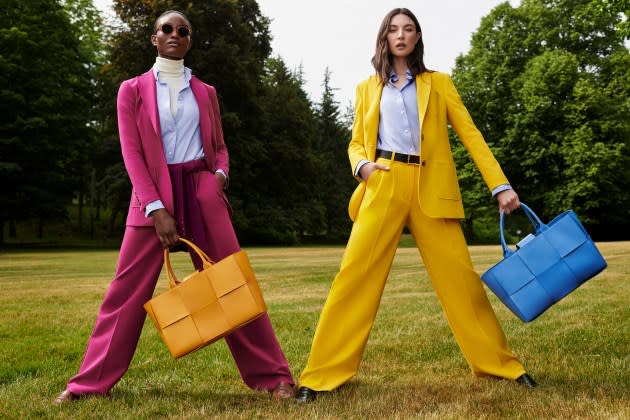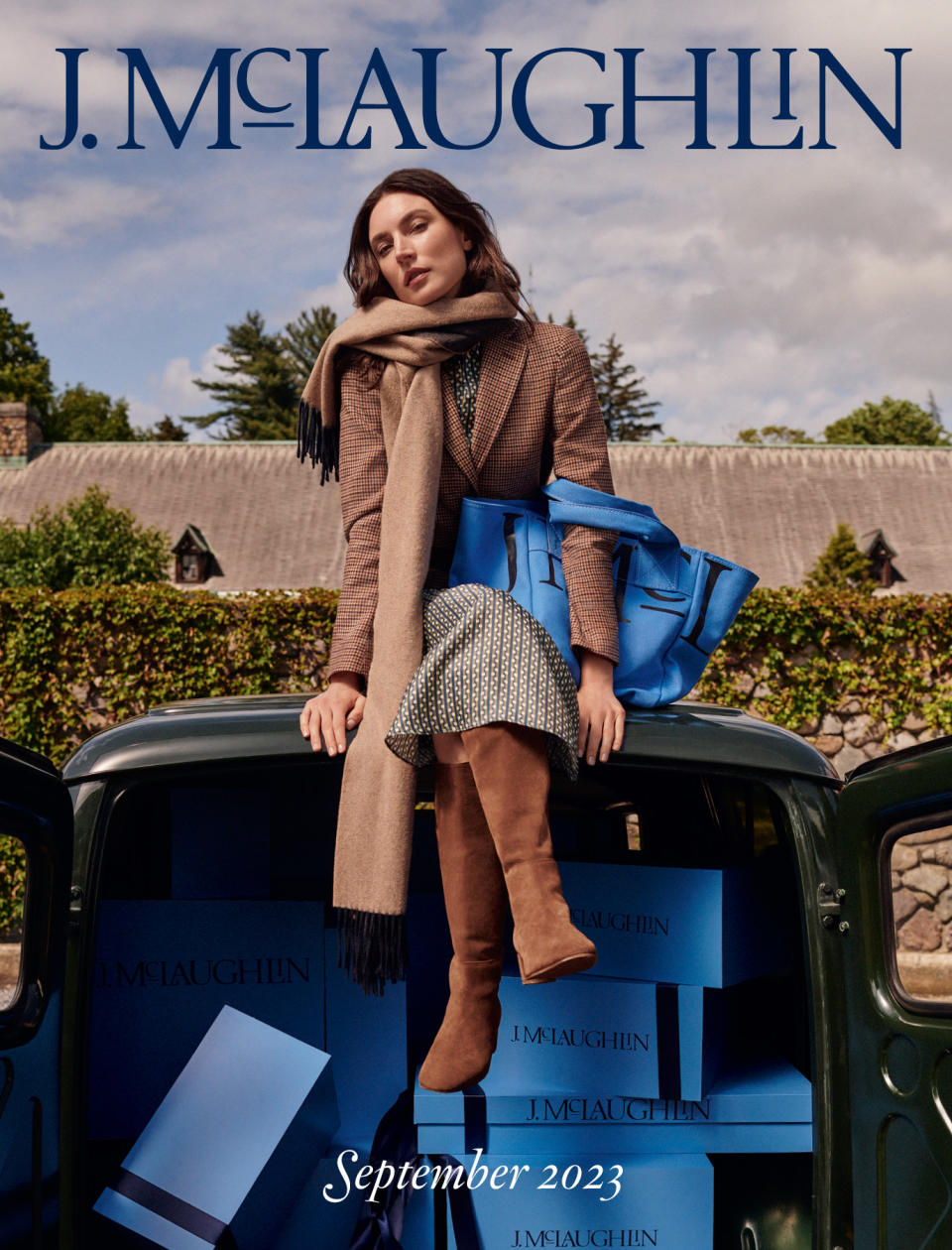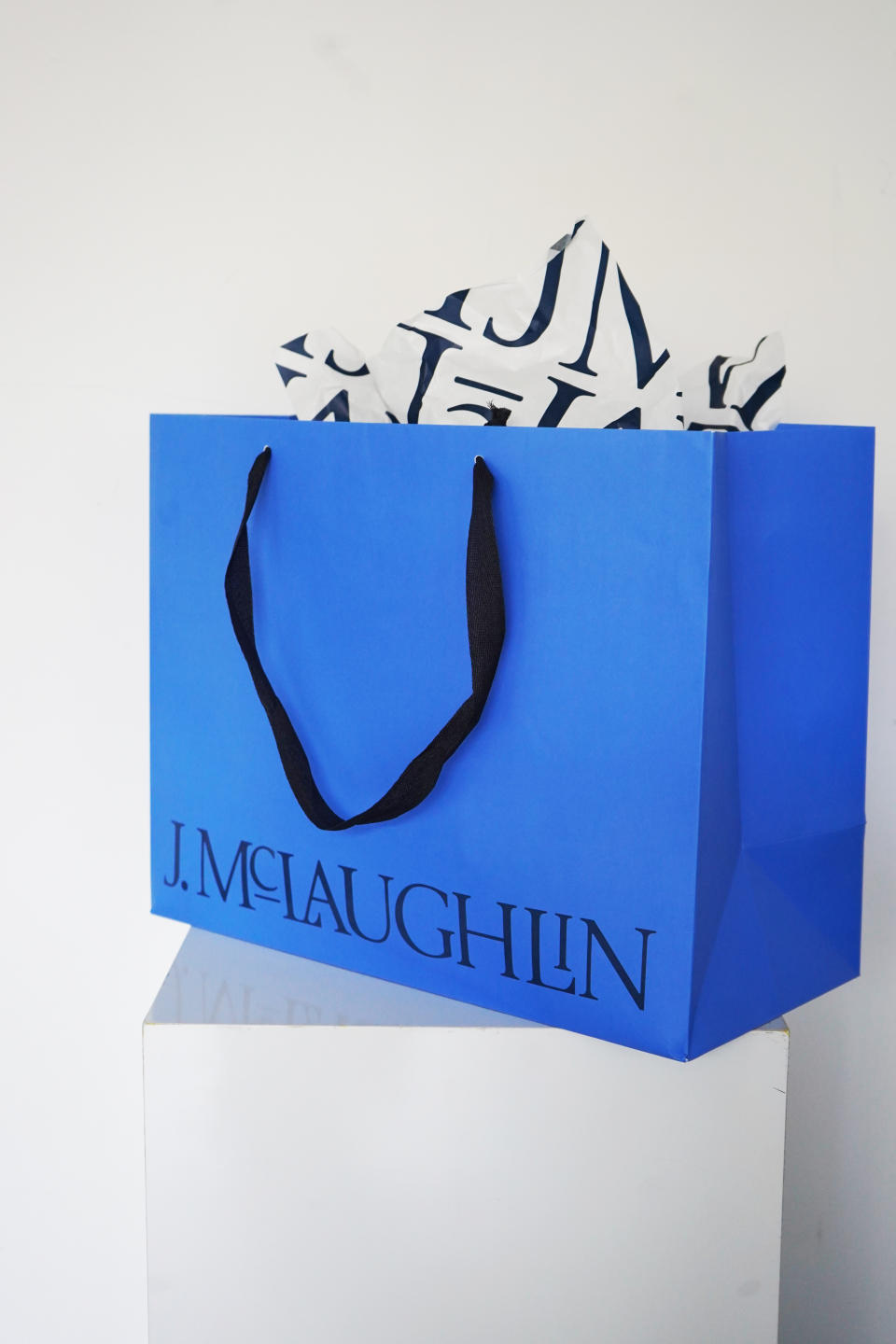J.McLaughlin Pivots With a Reimagined Campaign

After years of quiet and patient growth, J.McLaughlin is ready to make some noise.
For fall, the imagery is updated; catalogues and the website have higher-quality photography and bolder graphics; investment clothing, suits and menswear are gaining ground in the assortment, and the company is back on pace of 10 or more store openings per year after slowing down during the COVID-19 pandemic.
More from WWD
The company’s signature blue, always widely applied to products and marketing assets, is now a deeper blue, and the company switched out its logo and revived the one from the ’80s. Coming soon: wild postings in four cities.
“For the first time in our 46-year history, we’re launching a creative upgrade and it’s in partnership with campaign legend Trey Laird. This is a tremendous evolution,” said Mary Ellen Coyne, J.McLaughlin’s chief executive officer. “People will notice and really understand that the brand is making a statement.”

She described the fall book, which begins arriving at homes Tuesday, as “completely fresh and new in terms of the photography and the art direction.” Laird handled the fall campaign creative and branding graphic identity, while the imagery in catalog and campaign was shot by Dan Martensen and styled by Clare Richardson.
“We’re exploring other new and interesting marketing channels,” said Coyne. “We are doing wild postings — those oversized images on scaffolding and construction sites — in New York; Washington, D.C.; Houston, and Nashville. We’re refreshing our social site. We’re refreshing digital. The in-store store experience will be different and outside, we’re changing the awnings and doors so the color palette matches this new intense blue. We’re using Pantone 2727, with navy. The brand was always about blue. The blue is just much more elevated and intense.
“Everything that’s customer-facing is being updated. The customer will really feel it.”
For the fall campaign, said Coyne, “We looked at the archives and took things from the brand’s past and brought them forward, to an elevated level,” including the logo, the packaging and the graphics.
“Together with Trey, we reimagined the brand through a creative campaign that ushers in a new age for J.McLaughlin while remaining true to its core, which is timeless classics with fresh relevance.”
Coyne recalled the breakfast with Kevin McLaughlin, chief creative officer and cofounder of the brand along with his brother Jay, and Laird, who is well-known for developing innovative campaigns for Tommy Hilfiger, Karl Lagerfeld, Jimmy Choo, Tom Ford, Calvin Klein, SoulCycle, Estée Lauder, Coach and other top brands.
“We knew right away he was the best person to help us move the brand forward while staying completely true to who we are,” said Coyne. “We love his approach and his understanding of great American brands where he’s done a lot of work.”
“Sometimes you can’t see the forest through the trees,” said Kevin McLaughlin. “We’re here every day doing the fundamentals of our business and we decided that Trey should come in and look at things with a fresh set of eyes to give us stimulation and direction. It’s been a great fit. He’s strongly opinionated, but he is also a very good listener. He listened to all of us, and frankly, it was critical that he was able to take us a little further than we’re capable of going on our own.”
“What immediately struck me about J.McLaughlin was their very personal and strong relationship with their customer,” Laird told WWD. “A big part of their growing success is their commitment to local communities. In this day of online everything, and big flashy retail flagships on major shopping streets in every capital, it is refreshing to see a brand adopt a hyper-local, highly personal approach as a hallmark of their strategy. I can’t think of another apparel brand that has executed this so well.”
Laird also credited J.McLaughlin with continuing to evolve its design DNA as well as updating the overall image. “They have built a very successful business but very under the radar,” said Laird. “As they now push to welcome new audiences into the brand, there is so much blue sky to grow. I had always thought of J.McLaughlin as a very traditional, straight-up preppy classic brand. And while that is a big part of their heritage, they have done a really great job evolving that design language into a much more contemporary take on classic style. They are offering a much fresher take on print and color and styles in general — all with an eye toward their customer and evolving along with them.”
“We’re continuing to work with Trey,” said Coyne. “He executed the September and October books. Through Trey’s guidance, we elevated the level of the photography, the styling, the models. You really do feel that in the books.”

McLaughlin said the collection and sales are returning to “true investment clothing.”
“We’re feeling that in terms of the suiting, in terms of menswear jackets and the shirting piece of it, and just putting it together in a way that feels new. These are beautiful signature pieces we have that hadn’t been in the brand in a very long time.”
He also cited more vibrant colors, technical aspects of fabrications that provide greater drape and depth of color, and versatility, so for example, suit jackets and trousers can be worn as separates. “Pairing a colorful trouser with a cashmere turtleneck or taking the jacket from the suit and matching it with a white shirt and jeans is fabulous,” he said.
Dresses, chunky sweaters, cashmere and prints, he cited as continuing major components of the business. “When you look at the book, you’ll see that the prints are more modern and abstract.”
While the women’s side of the business has grown nicely, McLaughlin acknowledged menswear had fallen behind. “Now we have come back to it,” he said. “We are dedicating more pages in the catalogues and more real estate in the stores. The sport coat has become tremendously important. It’s evolved from its classic use as a sport coat to what would be the final layering piece.”
Men’s shoes were launched last fall, and on the active side, men’s is “strongly rooted” in golf, McLaughlin said. “In some of our stores, golf has a 12-month a year presence. We’re debating whether it remains in all of our stores on a continual basis. We’ve had great reception to the polo shirts, the shorts, windbreakers and the technical pants.”
Coyne said J.McLaughlin has been in the active women’s category for a long time, though, “We really started to lean in and put together tighter packages about 18 months ago. We find that our unexpected signature J.McLaughlin prints, that don’t look like typical active prints, are a home run.”
On the brick-and-mortar front, Coyne said that by the end of this year, 10 new stores will have opened, and another 10 to 15 are planned for the next three to five years. “We’ve had a great presence in the Northeast, the mid-Atlantic, and the Southeast, Florida being our number-one most highly penetrated state. Over the last 10 years, we’ve established a foothold in California and Colorado, coming back to Texas and in Arizona. Now we’re very intrigued and spending time investigating the Midwest, in underserved markets, affluent communities that we haven’t covered yet.”
Asked about catalogue growth, Coyne said that since 2019, it has tripled its distribution to 10 million copies annually currently. Nine editions are created each year.
“I can tell you our business is very strong in stores and in e-commerce. We have had consistent growth, including this year, for the last 10 years,” said Coyne.
Most other specialty fashion retailers and department stores are struggling this year with declining sales. “Fortunately we are bucking the trend,” Coyne contended. “And we’ll have another very strong year this year.” Being privately held by the Brentwood Associates private equity firm, the company does not disclose financial figures. Brentwood has owned J.McLaughlin for more than eight years, which is a long time in the world of private equity firms that typically look to cash out on investments sooner.
“Things start with the product. That always will be number one, and we seem to have evolved nicely,” McLaughlin said. “We’ve done a lot of things right for a long time and so there is a loyalty of the base that we have.” J.McLaughlin’s customer tends to be affluent, well-educated and 30 and older. “The point of what we’re doing with Trey is to increase that base, to get the word out, to expand our audience,” McLaughlin said.
“As Kevin likes to say, the client grows into this brand,” Coyne added. “This brand is appropriate for a certain point in their life.”

J.McLaughlin’s new deep blue packaging.
Best of WWD